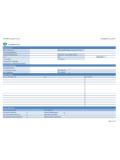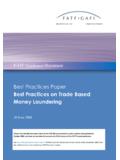Transcription of Annex 9 Guide to good storage practices for …
1 125 World Health OrganizationWHO Technical Report Series, No. 908, 2003 Annex 9 Guide to good storage practices and and recall134 References134 Bibliography134 Appendix136 storage and labelling Guide is intended for those involved in the storage , transpor-tation and distribution of pharmaceuticals. It is closely linked toother existing guides recommended by the WHO Expert Committeeon Specifications for Pharmaceutical Preparations, such as: good trade and distribution practice (GTDP) of pharmaceuticalstarting materials (1); The stability testing of pharmaceutical products containingwell-established drug substances in conventional dosage forms(information given in connection with regulation for marketingauthorization) (2); good manufacturing practices (GMP) (3);1 This guidance has been prepared in close collaboration with the InternationalPharmaceutical Federation (FIP).
2 126 The cold chain, especially for vaccines and biologicals; The International Pharmacopoeia (4).The objective of this Guide is to supplement the above-mentioneddocuments by describing the special measures considered appropriatefor the storage and transportation of pharmaceuticals. However, theymay be adapted to meet individual needs where necessary, providedthat the desired standards of quality are still guidelines are applicable not only to manufacturers of medicinalproducts but also to pharmaceutical importers, contractors andwholesalers, and community and hospital pharmacies. They should beadjusted in line with the type of activity where the storage of pharma-ceuticals is taking place. National or regional regulations should befollowed for all related definitions given below of some of the terms used in this docu-ment take into account the terminology of current regulations pharmaceutical ingredient (API)
3 Any substance or mixture of substances intended to be used in themanufacture of a pharmaceutical dosage form and that, when used inthe production of a drug, becomes an active ingredient of that substances are intended to furnish pharmacological activity orother direct effect in the diagnosis, cure, mitigation, treatment orprevention of disease, or to affect the structure and function of undesired introduction of impurities of a chemical or microbio-logical nature, or of foreign matter, into or onto a starting material, orintermediate or finished product during production, sampling, pack-aging or repackaging, storage or of a starting material, intermediate product or fin-ished product with another starting material or product substance, other than the active ingredient, which has been ap-propriately evaluated for safety and is included in a drug deliverysystem to:127 aid in the processing of the drug delivery system during itsmanufacture; protect, support or enhance stability, bioavailability, or patientacceptability; assist in product identification; or enhance any other attribute of the overall safety and effectivenessof the drug during storage or dateThe date given on the individual container (usually on the label) of adrug product up to and including which the product is expected toremain within specifications, if stored correctly.
4 It is established foreach batch by adding the shelf-life to the date of action involving the selection of the correct label, with therequired information, followed by line clearance and application ofthe operations of purchase of materials and products, production,quality control, release, storage and distribution of finished products,and the related general term used to denote starting materials (active pharmaceu-tical ingredients and excipients), reagents, solvents, process aids,intermediates, packaging materials and labelling materialAny material, including printed material, employed in the packagingof a pharmaceutical product, but excluding any outer packaging usedfor transportation or shipment. Packaging materials are referred to asprimary or secondary according to whether or not they are intendedto be in direct contact with the productAny medicine intended for human use or veterinary product admin-istered to food-producing animals, presented in its finished dosageform or as a starting material for use in such a dosage form, that issubject to control by pharmaceutical legislation in both the exportingstate and the importing operations involved in the preparation of a pharmaceutical prod-uct, from receipt of materials, through processing, packaging andrepackaging, labelling and relabelling.
5 To completion of the dateThe date when a material should be re-examined to ensure that it isstill suitable for storing of pharmaceutical products and materials up to theirpoint of person providing pharmaceutical products and materials on re-quest. Suppliers may be agents, brokers, distributors, manufacturersor traders. Where possible, suppliers should be authorized by a com-petent At each storage site ( that of a manufacturer, distributor,wholesaler, community or hospital pharmacy) there should be anadequate number of qualified personnel to achieve pharmaceuticalquality assurance objectives. National regulations on qualificationsshould be All personnel should receive proper training in relation to goodstorage practice, regulations, procedures and All members of staff should be trained in, and observe high levelsof, personal hygiene and Personnel employed in storage areas should wear suitable protec-tive or working garments appropriate for the activities they and facilitiesStorage Precautions must be taken to prevent unauthorized persons fromentering storage storage areas should be of sufficient capacity to allow the orderlystorage of the various categories of materials and products, namelystarting and packaging materials, intermediates, bulk and finishedproducts, products in quarantine, and released, rejected.
6 Returned orrecalled storage areas should be designed or adapted to ensure goodstorage conditions. In particular, they should be clean and dry andmaintained within acceptable temperature limits. Where specialstorage conditions are required on the label ( temperature, rela-tive humidity), these should be provided, checked, monitored andrecorded. Materials and pharmaceutical products should be storedoff the floor and suitably spaced to permit cleaning and should be kept in a good state of cleanliness and storage areas should be clean, and free from accumulated wasteand vermin. A written sanitation programme should be availableindicating the frequency of cleaning and the methods to be used toclean the premises and storage areas. There should also be a writtenprogramme for pest control.
7 The pest-control agents used should besafe, and there should be no risk of contamination of the materialsand pharmaceutical products. There should be appropriate proce-dures for the clean up of any spillage to ensure complete removal ofany risk of Receiving and dispatch bays should protect materials and prod-ucts from the weather. Reception areas should be designed andequipped to allow containers of incoming materials and pharmaceuti-cal products to be cleaned, if necessary, before Where quarantine status is ensured by storage in separate areas,these areas must be clearly marked and their access restricted toauthorized personnel. Any system replacing physical quarantineshould provide equivalent security. For example, computerized sys-tems can be used, provided that they are validated to demonstratesecurity of There should normally be a separate sampling area for startingmaterials in a controlled environment.
8 If sampling is performed inthe storage area, it should be conducted in such a way as to preventcontamination or cross-contamination. Adequate cleaning proce-dures should be in place for the sampling Physical or other equivalent validated ( electronic) segregationshould be provided for the storage of rejected, expired, recalled orreturned materials or products. The materials or products, and areasconcerned should be appropriately Highly active and radioactive materials, narcotics and otherhazardous, sensitive and/or dangerous materials and pharmaceuticalproducts, as well as substances presenting special risks of abuse, fireor explosion, ( combustible liquids and solids and pressurized130gases) should be stored in a dedicated area that is subject to appropri-ate additional safety and security Materials and pharmaceutical products should be handled anddistributed according to GMP as defined in this Materials and pharmaceutical products should be handled andstored in such a manner as to prevent contamination, mix-ups Materials and pharmaceutical products should be stored in con-ditions which assure that their quality is maintained, and stock shouldbe appropriately rotated.
9 The first expired/first out (FEFO) prin-ciple should be Rejected materials and pharmaceutical products should be iden-tified and controlled under a quarantine system designed to preventtheir use until a final decision is taken on their Narcotic drugs should be stored in compliance with internationalconventions, and national laws and regulations on Broken or damaged items should be withdrawn from usablestock and storage areas should provide adequate lighting to enable alloperations to be carried out accurately and storage conditions for pharmaceutical products and materialsshould be in compliance with the labelling, which is based on theresults of stability testing (see Appendix).Monitoring of storage Recorded temperature monitoring data should be available forreview. The equipment used for monitoring should be checked atsuitable predetermined intervals and the results of such checks shouldbe recorded and retained.
10 All monitoring records should be kept forat least the shelf-life of the stored material or product plus 1 year, oras required by national legislation. Temperature mapping shouldshow uniformity of the temperature across the storage facility. It isrecommended that temperature monitors be located in areas that aremost likely to show Equipment used for monitoring should also be calibrated atdefined requirementsDocumentation: written instructions and Written instructions and records should be available which docu-ment all activities in the storage areas including the handling of ex-pired stock. These should adequately describe the storage proceduresand define the route of materials and pharmaceutical products andinformation through the organization in the event of a product recallbeing Permanent information, written or electronic, should exist foreach stored material or product indicating recommended storage con-ditions, any precautions to be observed and retest dates.












